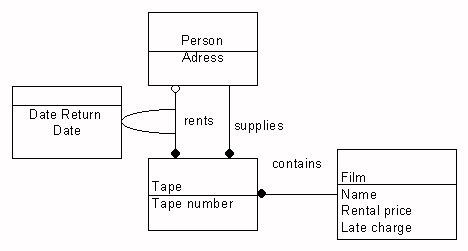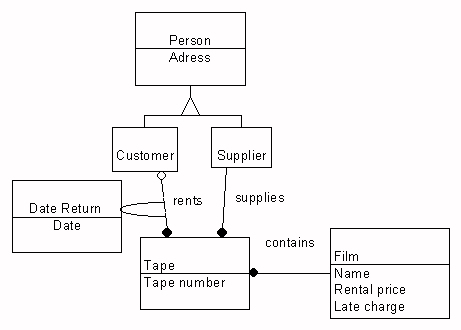OMT Object Model



Identify object classes
Here are the nouns found in the video-store
example:
Video store, tape request, tape customer, tape supplier, tape
overdue notice, store assistant, information, film, tape, list of
rentals, tape return, task, activity, submission of rate changes,
submission of new tapes, store management, production, rental
report, store administration.
For this example we only consider the nouns that are related to the
problem of video-renting. These are the classes that remain if we
discard all the unnecessary and incorrect classes, following the
given criteria (the remaining classes are in italics):
 Video store: irrelevant
Video store: irrelevant
 Tape
Tape
 (tape) Request: operation
(tape) Request: operation
 (tape) Customer: role
(tape) Customer: role
 (tape) Supplier: role
(tape) Supplier: role
 (tape) Overdue notice: vague
(tape) Overdue notice: vague
 Store assistant: irrelevant
Store assistant: irrelevant
 Information: vague
Information: vague
 Film
Film
 Rental: vague
Rental: vague
 List (of rentals): vague
List (of rentals): vague
 (tape) Return: operation
(tape) Return: operation
 Task: irrelevant
Task: irrelevant
 Activity: irrelevant
Activity: irrelevant
 Submission of rate changes: operation
Submission of rate changes: operation
 Rate: attribute
Rate: attribute
 Submission of new tapes: operation
Submission of new tapes: operation
 Store management: irrelevant
Store management: irrelevant
 Production: operation
Production: operation
 (rental) Report: vague
(rental) Report: vague
 Store administration: irrelevant
Store administration: irrelevant
Customer is a role-name. It is better to say something about the
intrinsic nature of the class instead of its role in an association. So
we rename "Customer" to "Person". The same counts for
"Supplier".
Prepare a data dictionary
Next, we prepare a data-dictionary, in which we describe each
class.
Person: A person can rent video-tapes, if he is a supplier
he can submit supply tapes
Film: this is what a customer wants to see, and what's on
a tape
Tape: a tape contains a film, there may exist many tapes
of the same film.
Define associations
Next, we define the associations. After having rejected some
candidate-associations, we come to the following associations:
 Person rents a tape
Person rents a tape
 Person is supplies of a tape
Person is supplies of a tape
 Tape contains a film
Tape contains a film
This gives us the following schema:

After specifying the semantics of the associations, we come to the
following schema:

These are the attributes we could find for the classes:
Person: address
Tape: tape number
Film: name, rental price, late charge
Furthermore, there also exists a link-attributes in the association
rents. For every rental the following things are
recorded:
 Date
Date
 Return date
Return date
After having found the attributes we can draw the following
schema:

The class person can be refined using inheritance. We can make
two specializations, namely "customer" and "supplier".
This gives us the following schema:

In this last schema access-paths for the most likely queries do exist.
All information concerning the tapes and films is available in the
attributes of this objects. Overdue notices can be generated by
looking at the 'return-date' attribute of the 'rents'-association. This
way, the store assistant can also check if the customer is late with
the return of tapes.
This last schema can be further enhanced using iteration, i.e. going
back to earlier stages in the design-trajectory.


 Last modified: February 8th, 1996
Last modified: February 8th, 1996
Henk Enting, h.d.enting@cs.utwente.nl Video store: irrelevant
Video store: irrelevant Tape
Tape (tape) Request: operation
(tape) Request: operation (tape) Customer: role
(tape) Customer: role (tape) Supplier: role
(tape) Supplier: role (tape) Overdue notice: vague
(tape) Overdue notice: vague Store assistant: irrelevant
Store assistant: irrelevant Information: vague
Information: vague Film
Film Rental: vague
Rental: vague List (of rentals): vague
List (of rentals): vague (tape) Return: operation
(tape) Return: operation Task: irrelevant
Task: irrelevant Activity: irrelevant
Activity: irrelevant Submission of rate changes: operation
Submission of rate changes: operation Rate: attribute
Rate: attribute Submission of new tapes: operation
Submission of new tapes: operation Store management: irrelevant
Store management: irrelevant Production: operation
Production: operation (rental) Report: vague
(rental) Report: vague Store administration: irrelevant
Store administration: irrelevant





